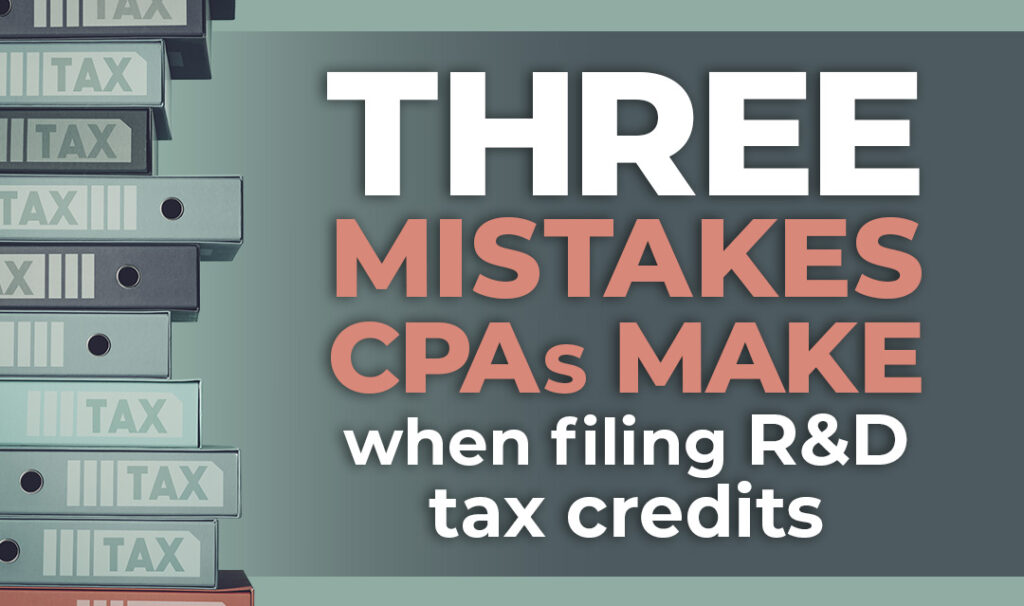Think Filing R&D Tax Credits is Easy? Think Again…
Are you filing R&D tax credits for your clients? Are you sure you’ve got everything correct? We get it—it can be a lot of pressure! Getting it right is a big deal; the credit, rooted in Section 41 of the IRS Code, can save businesses thousands, in some cases even millions, by offsetting costs tied to innovation. But here’s the catch: it’s more complex than it seems at first glance. One misstep and your client could miss out on significant savings, face an audit, or owe penalties. Due to recent changes regarding R&D credits, including unfavorable court rulings and new IRS documentation requirements for credit filings, it is more crucial than ever to conduct an accurate R&D study. At Firestone Tax Solutions, we’ve seen it all—and helping our clients avoid those small mistakes (that could cost big money!) is our number one priority.
So, let’s break down the top three pitfalls CPAs make when trying to tackle R&D credits — spoiler alert: our team is always here and ready to help when it gets tricky!
1. Missing Eligible Costs—or the Right Elections
Have you ever filed an R&D credit and felt a nagging doubt about whether you caught everything? You’re not alone. Lots of great CPAs overlook buckets of eligible costs—think direct support (like assembly or testing time for R&D projects) or supervision (a manager overseeing a prototype build). These aren’t always obvious, especially if you’re not a specialist.
Then there’s the Section 280C election: gross vs. net. In recent years, our team spotted some tax pros electing net credit when gross would’ve undoubtedly saved more. In one case, an incorrect election cost a taxpayer over $17,000 in a single year. It’s complex, year-dependent math that trips up even seasoned CPAs.
The Fix: Dig deeper into cost categories and run the tax impact of both the gross credit and the net credit every year. Firestone Tax Solutions specializes in spotting these hidden savings—be sure to contact us, and we’ll make sure you’re getting every penny of the R&D tax credit on your next filing.
2. Skimping on Business Component Analysis
Just in case anyone needs a reminder — the IRS doesn’t play around with R&D credits. Skip a proper business component analysis—tying each expense to a specific innovation goal—and you’re asking for trouble. If an audit could force your client to repay the credit, plus penalties & interest. Starting in 2024, some level of this analysis isn’t optional; it’s 100% required. Yet, too many CPAs treat it as an afterthought, assuming costs speak for themselves. Businesses can lose big on credits if their filing doesn’t have the backbone to hold up under IRS scrutiny.
The Fix: Document how each cost ties to a qualified project. Feeling overwhelmed by the scope of the analysis required to claim the R&D tax credit and want to make sure you get it right? At Firestone, we specialize in handling the R&D tax credit. It’s what we do. Trust our experience, and let us do the heavy lifting— schedule a consultation to keep your clients audit-ready.
3. Overlooking Section 174 Cost Analysis for Capitalization
Here’s a big one: conflating Section 41 (R&D credit-eligible expenses) with Section 174 (research costs to capitalize and amortize). Nope, they’re not the same, but plenty of tax preparers assume that they are, tossing R&D credit numbers into the amortization bucket. This approach falls short, as section 174 demands its own analysis—think employee benefits, utilities, and other indirect costs related to the R&D function. Mess this one up and your client faces big-time audit risks, penalties, and a potentially heavy tax bill they didn’t see coming.
The Fix: Conduct a detailed analysis to compute Section 174 costs with precision. Or just call Firestone Tax Solutions and let our team dig into the details for you. Contact us today and protect your client’s bottom line.
Why Precision Pays Off
R&D tax credits are quite valuable —when done right! The average small business that’s eligible for the R&D credit claims $75,000 annually, per IRS data, but errors can shrink that fast. At Firestone Tax Solutions, we’ve helped many clients save money and remain compliant by catching what others miss. One tech company successfully retained R&D credits of $850K under an IRS audit based on business component analysis and support prepared by Firestone.
Filing R&D credits isn’t just about compliance—it’s about boosting your clients’ tax savings. Don’t let these traps trip you up! Claim every dollar your clients deserve—reach out to Firestone Tax Solutions for expert support.
Claim every dollar your clients deserve—visit firestonetax.com or call (208) 416-1039 to partner with us.

